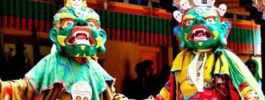The Diverse Rituals of Holi in Various Regions of India
Holi, also known as the festival of colors, is one of the most vibrant and joyous festivals celebrated across India. While the essence of Holi remains the same throughout the country – the triumph of good over evil and the arrival of spring – the way it is celebrated varies from region to region. Let’s delve into the diverse rituals of Holi observed in different parts of India, showcasing the cultural and regional variations that make this festival truly unique.
North India – Holika Dahan
In North India, the festivities of Holi kick off with the ritual of Holika Dahan, also known as Chhoti Holi. This ritual involves lighting a bonfire to commemorate the victory of Prahlad over the demoness Holika. People gather around the bonfire, perform prayers, and throw offerings like grains, coconut, and sweets into the fire. The next day, known as Rangwali Holi, is when the famous color-throwing festivities take place.
Bengal – Dol Jatra
In Bengal, Holi is known as Dol Jatra or Dol Purnima. The main ritual of this region involves placing the idols of Radha and Krishna on a beautifully decorated palanquin or a swing and carrying them around the streets amidst singing and dancing. Devotees throw colored powders and flowers at each other and the deities, symbolizing the divine love between Radha and Krishna. The festive atmosphere is further enhanced by traditional folk songs and dances.
Manipur – Yaosang
In Manipur, Holi is celebrated as Yaosang, which is a fusion of the traditional Manipuri festival with the Hindu festival of Holi. The week-long celebrations include community feasting, cultural performances, and sports activities. One of the unique features of Yaosang is the Thabal Chongba dance, where young men and women hold hands and dance in a circle under the moonlight. The festival promotes harmony and unity among different communities in Manipur.
Maharashtra – Rang Panchami
In Maharashtra, Holi is celebrated as Rang Panchami, which falls five days after the main day of Holi. On this day, people play with colors, water balloons, and water guns, just like in other parts of the country. However, what sets Rang Panchami apart is the ritual of breaking clay pots filled with buttermilk, known as Dahi Handi. Groups of young men form human pyramids to reach and break the pot, symbolizing the playful antics of Lord Krishna stealing butter.
South India – Kamadahanam
In South India, especially in Andhra Pradesh and Telangana, Holi is celebrated as Kamadahanam. This festival is associated with the legend of Lord Shiva burning Kamadeva, the god of love, to ashes. People light a bonfire and offer prayers to Lord Shiva, seeking his blessings for a blissful and prosperous life. The next day, people play with colors and indulge in festive meals with family and friends.
The festival of Holi exemplifies the rich cultural tapestry of India, with each region adding its unique flavors and rituals to the celebrations. From the bonfires of Holika Dahan in North India to the colorful processions of Dol Jatra in Bengal, and the exuberant dances of Yaosang in Manipur, Holi truly unites the country in a riot of colors and festivities. Regardless of the regional variations, the underlying message of love, unity, and joy remains constant, making Holi a beloved and cherished festival for people across India.







